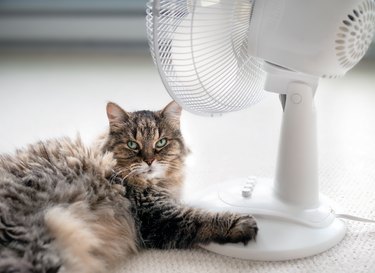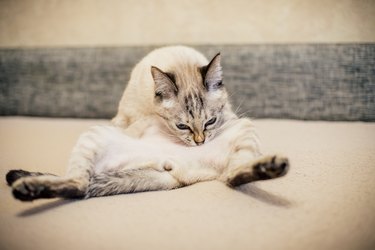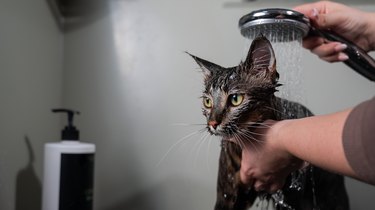Elegant creatures that they are, cats aren't really known for being sweaty messes when the weather gets hot. But, do cats sweat? And if they do, why can't we see it or feel it on their fur? Every animal has a built-in temperature regulation system to keep their bodies cool when things heat up around them and cats are no different, although their process looks quite different from our own.

Video of the Day
Do cats sweat?
Yes, cats do sweat! You probably haven't noticed as they aren't beading up on their foreheads or under their armpits like we do, but that's just because felines don't have sweat glands in those areas. A cat's sweat glands are located in the hairless areas of their bodies, like on their paw pads. This would help to keep an ancient cat's feet protected from the hot desert floor of the Middle East, which is where all cats originate from. You may even notice that your cat's paw feels a little moist from time to time, or maybe you've seen damp footprints around your house, which is likely due in part to their sweat glands working. Not only are a cat's sweat glands limited to fewer areas of the body but they also have fewer sweat glands in that area, and sweating is hardly a resource cats use to keep themselves cool.
Video of the Day
How do cats cool down?
So, if cats have barely any sweat glands, how do they regulate their body temperature and stay cool when it's hot out? They go the DIY route. Sweat cools us down by evaporating the moisture that our sweat glands create. The same thing happens if we were to spray or douse ourselves with water. Cats apply this same concept to temperature control, only they use saliva as their water source. That's right—all that grooming you see is done in part to keep your feline friend cool and comfortable, which is why you may see your cat licking their fur more in the warmer months.

How to tell if your cat is overheating
Just because a cat is able to lick their fur as a cooling method doesn't mean that they can't overheat. Cats can tolerate higher temperatures due to their genetics, and because a cat's body temperature is naturally higher than our own, generally measuring between 101 to 102.5°F. A cat with an abnormally high body temperature will usually become lethargic, and may even pant in an effort to cool themselves down through their mouths. This is highly unusual, so if you see your cat pant, notice them acting sluggish, or see them pressing their bellies against a cool surface like a tile floor you'll want to take immediate action to prevent heatstroke, heat exhaustion, or other medical emergencies.
Tips for keeping your cat cool
Cats are built to withstand heat, so you won't need to do too much to help them stay cool. That said, offering your cat shade on a hot day is essential, especially if they spend time outdoors or lounging in front of a sunny window. Additionally, making sure there's always fresh water available during hot weather conditions will go a long way in preventing heat-related cat health problems. Many cats get a lot of their hydration needs met by eating wet food, so if your cat isn't an avid water drinker and the temperatures are rising with warm weather or summertime sun, it may be helpful to offer them a wet meal from time to time.

If your cat has become too hot and you need to cool them down, you'll want to move them to a shady, cooler area, or ideally, a room with air conditioning. Next, adding water to their fur will cool them down quickly. You'll want to do this gently and carefully, especially if your cat doesn't care for water, so soaking a washcloth in cold water and slowly wiping it over their body is recommended. You can also point a fan toward your cat to get the evaporation process (that is, the cooling process) started right away.
The bottom line
Cats can and do sweat, just not very much. Cats have far fewer sweat glands than people, and most of them are located on their paw pads to protect them from touching hot ground on warm days. Rather than rely on sweating to regulate their body temperatures, cats use the evaporation of their own saliva through grooming to cool off. Always provide shade and fresh water to help keep your cat cool, and if they become lethargic or if you notice them drooling or panting, take them to a cool room and wet them down gently to help them cool down quickly.